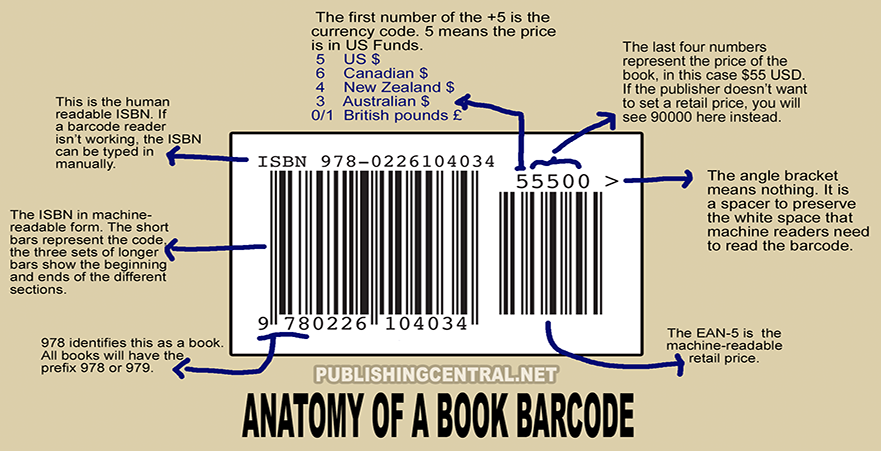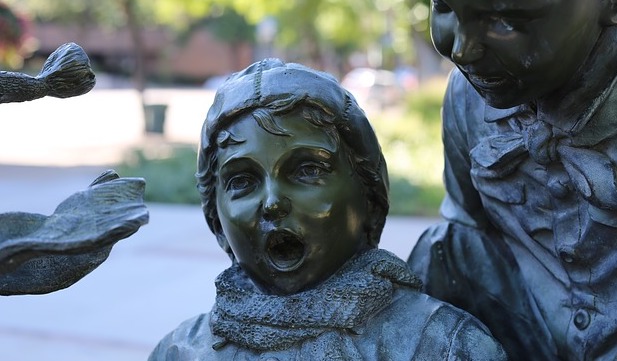ISBN Frequently Asked Questions
For many first-time publishers and self-published authors, getting an ISBN and barcode on their books seems like an unimportant formality. It is, however, a vitally important part of your book publishing strategy that shouldn't be neglected.

What is an ISBN?
The ISBN (International Standard Book Number) system was established in 1968 as a standard identification system for books and other monographic publications. Today all book databases use the ISBN to track books, and almost every item found in a bookstore has one.
Do I need an ISBN?
If you want to make any sales to bookstores, you need to have an ISBN. If you want people to be able to find your book in the Books
in Print directory, you need an ISBN. If you are publishing a book, odds are that not having one will do nothing but hurt your sales.
How do I get an ISBN?
If you're in the United States,
ISBNs are managed by
R.R. Bowker
121 Chanlon Road,
New Providence, NJ 07974
Phone (908) 665-6770 Fax (908) 665-2895
The easiest way to proceed is to set up an account and purchase your ISBN block here.
In Canada contact:
The National Library of Canada
395 Wellington Street
Ottawa, ON
Phone: (819) 994-6872 Fax: (819) 997-7517
Create an ISBN Canada account at Library and Archives Canada, and request your ISBN prefix online.
In the United Kindom contact:
In the UK, Republic of Ireland and British Overseas Territories, ISBNs are administered by Nielsen.
The UK ISBN Agency
12 Dyott Street
London WC1A 1DF
Phone:(+44 )0207420 6008
You can order your ISBNs online from Nielsen ISBN Agency here.
The cost of a block of ISBNs depends on which country you're applying in, but the process is essentially the same. Fill in an application form and purchase the block size you want. While it is possible, at least in the United States, to purchase a single ISBN, it is far better to purchase a block of 10. You will need at least two numbers if you plan to publish in print as well as in ebook form, and having some spare for revised editions or hardcover formats is a good idea.
What do I do with it once I've got it?
The ISBN should be printed on the copyright page, and on the lower right hand corner of the back cover of your book in a font size between 9 and 12 points.. If you're using a dust jacket, the ISBN should also be on the upper edge of the left hand flap. If your product includes a disk or cassette, the ISBN should be printed on the label.
Every edition of your title should have a separate ISBN number. A hardcover copy should have a different ISBN than the softcover. An audio version
should have a different number again. If you change the cover of your book, or if you make significant changes to it, you should use a new ISBN. There is some disagreement as to whether you should
use a new ISBN when you change the price of a book, and there are advantages and disadvantages to doing either, but I believe notifying your wholesalers and Bowker of the change is sufficient.
What if I run out of ISBNs?
This happens from time to time. All you have to do is contact the agency you first got your block from, and request more. You may be
required to pay another fee, however, so it is a good idea to get a large enough block the first time around to last you a long long time. ISBNs don't expire, so you've got nothing to lose by
requesting the largest block you can.
What do the numbers mean?
An ISBN looks like this: ISBN 1-55105-083-8
The hyphens separate the different parts of the number: 1 : A 0 or a 1 in this position indicates that the book was published in an English speaking country (Click here for other ISBN Country Codes)
55105 : This is the identification number of the publisher
How Do I Figure Out the Check Digit?
The first 9 digits of your number are your true number - take that number and multiply the first digit by 10, the second by 9, the third by 8, the fourth by 7... and continue till the last digit, which you will multiply by 2.
Are the hyphens necessary to decode ISBNs?
Hyphens are not necessary to decode an ISBN. If you know the prefix ranges for each country code, you can determine where the hyphens go. In computer applications and databases it can be advantageous to remove the hyphens from the numbers to conserve space, and develop a hyphenation output program to replace them when required.
ISBN = 9 7 8 X X X X X X X X X Weighting Factors 1 3 1 3 1 3 1 3 1 3 1 3
083 : Identifies the specific title and edition
8 : is the check digit arrived at by following a special algorithm
Add up each of the resulting values to make a total sum.
This sum, plus the check digit must equal the least greatest multiple of 11.
If your sum is 256, the next multiple of 11 after 256 is 264. Since 264-256=8, the check digit is 8.
If the value of the check digit equals 10 make it an X. Thats why you can get an X in
the last place of the ISBN.
Since the country prefix for English-language books is either a 1 or a 0, a hyphen will follow the first digit, and since the check number is always one digit, a hyphen will follow the 9th digit. The following table shows where to insert the middle hyphen:
Country
Publisher ID
If number ranges are between:
Insert hyphen after the:
Block Size
0
00.......19
00-19
3rd digit
1,000,000
0
200......699
20-69
4th digit
100,000
0
7000.....8499
70-84
5th digit
10,000
0
85000....89999
85-89
6th digit
1,000
0
900000...949999
90-94
7th digit
100
0
9500000..9999999
95-99
8th digit
10
1
55000....86979
5500-8697
6th digit
1,000
1
869800...998999
8698-9989
7th digit
100
1
9990000..9999999
9990-9999
8th digit
10
13 Digit ISBNs
Effective January 1, 2007 the length of the International Standard Book Number (ISBN) will officially change from 10 to 13 digits. Over the next few years, the publishing industry will begin using 13-digit ISBNs, while phasing out the use of 10-digit ISBN’s.
This change will require all segments of the book industry to begin using 13-digit product identifiers when transacting business with their suppliers for books and instructional materials.
During the transition, some publishers will be using dual 10 and 13-digit ISBNs to identify their instructional materials. This will allow retailers to use either number as they make the transition to ISBN-13.
The EAN-13 currently displayed below (and encoded within) the Bookland EAN bar code is already a 13-digit equivalent of the current ISBN-10. This means that effective January 1, 2007, the EAN-13 will become numerically equivalent to the ISBN-13.
Organizations making system changes to handle ISBN-13 are encouraged to anticipate the future need to accommodate (store, view, and exchange) any of the EAN.UCC product identifiers which can be up to 14 digits long.
How can I convert my ISBN-10 into an ISBN-13?
Using the 12-digit number, multiply each digit by the weighting factor shown beneath it in the table above.
Add the
resulting values together.
Divide the sum by the modulus (which is always 10).
Using the
standard modulus (10), subtract the remainder from 10 to get the check
digit (last digit).
Add the
check digit to the end of the 12-digit number created in Step 2. The
conversion from a 10-digit ISBN to a 13-digit ISBN is complete.
There is one exception to this formula: whenever the remainder is zero
(0), the check digit is always zero (0) as well.

Read These Next
The Dangerous Side of Children’s Books
As an author, if you’re inspired to delve into the slightly dangerous, dark or subversive corners of childhood with your books, feel free to do so. Don’t limit yourself to all that’s bright, safe and up to code.
Succeed in your Resolution to Write a Novel This Year
If your resolution for the coming year is to finally finish that novel, here are some tips to help you successfully achieve that goal.
Ethical Considerations of Artificial Intelligence in the Publishing Industry
The increasing use of artificial intelligence (A.I.) in publishing and other creative industries poses ethical dilemmas that demand attention.







 Merchants of Culture: The Publishing Business in the Twenty-First Century
Merchants of Culture: The Publishing Business in the Twenty-First Century The Book Publishing Industry
The Book Publishing Industry Inside Book Publishing
Inside Book Publishing The Publishing Business: A Guide to Starting Out and Getting On (Creative Careers)
The Publishing Business: A Guide to Starting Out and Getting On (Creative Careers) Publishing for Profit: Successful Bottom-Line Management for Book Publishers
Publishing for Profit: Successful Bottom-Line Management for Book Publishers Big Fiction: How Conglomeration Changed the Publishing Industry and American Literature (Literature Now)
Big Fiction: How Conglomeration Changed the Publishing Industry and American Literature (Literature Now) The Design of Books: An Explainer for Authors, Editors, Agents, and Other Curious Readers (Chicago Guides to Writing, Editing, and Publishing)
The Design of Books: An Explainer for Authors, Editors, Agents, and Other Curious Readers (Chicago Guides to Writing, Editing, and Publishing) Before and After the Book Deal: A Writer's Guide to Finishing, Publishing, Promoting, and Surviving Your First Book
Before and After the Book Deal: A Writer's Guide to Finishing, Publishing, Promoting, and Surviving Your First Book Funny You Should Ask: Mostly Serious Answers to Mostly Serious Questions About the Book Publishing Industry
Funny You Should Ask: Mostly Serious Answers to Mostly Serious Questions About the Book Publishing Industry The Nonfiction Book Publishing Plan: The Professional Guide to Profitable Self-Publishing
The Nonfiction Book Publishing Plan: The Professional Guide to Profitable Self-Publishing